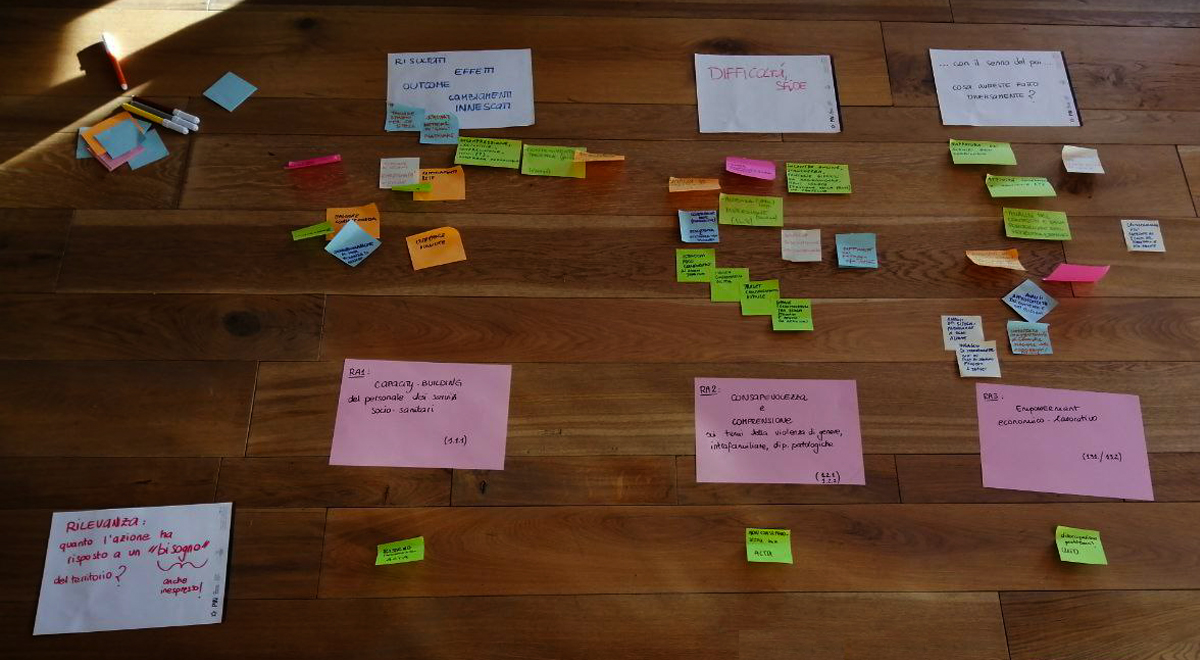The Outcome harvesting is an evaluation methodology that allows to explore the intended and unintended, positive and negative outcomes triggered by an intervention of its beneficiaries and main stakeholders. Rather than comparing the planned outcomes with the achieved ones, the Outcome Harvesting collects evidence of outcomes defined as the changes in behaviour, practices, relationships and actions of actors influenced by a change agent.
The main reference on this methodology is the publication by Ricardo Wilson-Grau and Heather Britt “Outcome Harvesting” (Ford Foundation, 2013) that is meant to enable evaluators, grant makers, and managers to identify, formulate, verify, and make sense of outcomes. As the authors explain, the Outcome Harvesting allows to analyse the outcomes of a project from many different perspectives. In particular it allows to address the key learning questions of an intervention; identify, formulate, analyze and interpret intended and unintended outcomes; develop a thorough understanding of the process of changes triggered by the intervention; determine the project contribution to the outcomes and estimate the importance of the outcomes.
The methodology is also useful to test the validity of the project Theory of Change by opening the “black box” of the path towards changes and to identify and analyze the main bottlenecks that hamper the project. The latter helps in formulating recommendations to improve the implementation of future projects.
When to use the outcome harvesting?
The outcome harvesting is particularly useful when:
- ● Theory of Change not clearly specified since the very beginning of the intervention;
- ● External factors and risks, as for example financial and /or political crisis, pandemic such as the Covid-19 outburst, undermine the project ToC. The activities, thus, are not performed as planned and the results triggered on the beneficiaries might be different from the planned ones;
- ● In complex intervention, when causalities between activities > outputs > outcomes > impact need to be better and further investigated;
- ● To deepen the understanding of the learnings arising from the intervention.
How to perform an outcome harvesting?
Wilson-Grau and Britt in their publication identify six main steps:
Design the harvest: Design the boundaries of the harvesting exploration area on the basis of the uses and users of the evaluation, and define the evaluation questions to be explored.
Review documentation and draft outcomes: Desk analysis of all the relevant documents, identification and validation of the main beneficiaries and stakeholders and first definition of the outcome statements.
Engage with change agents: Involvement of key informants to review, add and modify the outcome statements, to reach a thorough outcomes description.
Substantiate: Validate the outcomes both with internal stakeholders and external experts knowledgeable of the project so to verify their agreement on the outcome statement and collecting comments.
Analyse & interpret: The outcome statements are then organized in a database and analysed by using qualitative methods, so to reply to the evaluation questions.
Support the use of findings: Restitution of the evaluation results to the harvest users, highlighting points for discussions, best practices and recommendations.
In practice: the Outcome Harvesting of the project BADAEL
The project BADAEL, financed by the EU Regional Trust Fund “Madad”, aimed to foster social stability and community resilience through improved communities’ understanding of socio-economic opportunities and resilience assets in Lebanon. Its goal was to strengthen individuals’ skills to identify and engage in innovative sustainable solutions, while promoting social entrepreneurship as a mechanism for civic engagement. The M&E and Impact Evaluation Unit was contracted to conduct the evaluation study.
The project implementation, though, had to face several challenges. The Lebanese context was and keeps being characterized by several complexities, among which a weak governance structure, inadequate fiscal policies, and widespread corruption and nepotism. The high number of Syrian and Palestinian refugees poses an additional challenge to the already existing socio-economic problems. The political unrest in 2019, the price volatility, the currency devaluation and the covid-19 pandemic imposed changes in the original plan generating several unforeseen positive and/ore negative outcomes.
For these reasons, ARCO’s evaluating team decided to apply the outcome harvesting methodology and to enrich it with the EHD methodology as an added value.
In running the Outcome Harvesting, ARCO used its participatory and people-centered framework, the EHD-Evaluating Human Development methodology. Based on the capabilities approach of the Nobel prize Amartya Sen this methodology allowed s to apply a multidimensional lens in both designing the harvesting, outlining the evaluation tools, analyzing and interpreting the data.
